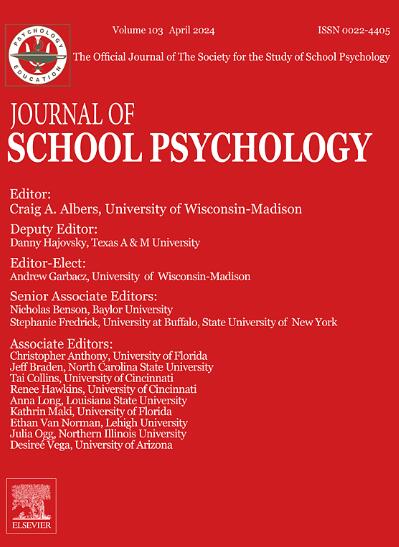Dual-factor mental health in adolescence: Comparing classification methods
IF 4.1
1区 心理学
Q1 PSYCHOLOGY, SOCIAL
引用次数: 0
Abstract
Addressing adolescent mental health difficulties often begins by first correctly identifying students who are at risk when using universal mental health screeners in the school setting. A comprehensive conceptualization of mental health may enhance school psychologists' ability to effectively understand the mental health of students they serve. The dual-factor model of mental health posits a more holistic approach to mental health by capturing subjective-wellbeing scores alongside psychopathology. When employing the dual-factor model, practitioners have various ways to classify students as at risk for mental health difficulties, including locally normed cut scores and latent profile analysis (LPA); without an empirical comparison between the two approaches, practitioners may be uninformed in their decision making. The present study surveyed 404 adolescents on subjective wellbeing and psychopathology and examined how mental health classification varied when two common dual-factor approaches were employed (i.e., locally normed cut scores and LPA). Results indicated that 71.2% of the sample were classified in the same dual-factor mental health group across the two approaches, whereas 28.8% of adolescents' mental health classifications changed. The lack of agreement between the two approaches for a sizable proportion of the present sample presents an area for future research to ensure the correct identification of at-risk students and appropriately allocate services in schools.
青少年的双因素心理健康:比较分类方法
要解决青少年的心理健康问题,通常首先要在学校环境中使用通用的心理健康筛查工具,正确识别有心理健康风险的学生。全面的心理健康概念可以提高学校心理学家有效了解所服务学生心理健康的能力。心理健康的双因素模型通过捕捉主观幸福感分数和心理病理学,提出了一种更全面的心理健康方法。在采用双因素模型时,从业人员有多种方法将学生划分为有心理健康问题的高危人群,包括当地标准切分分数和潜在特征分析(LPA);如果不对这两种方法进行实证比较,从业人员在做出决策时可能会不知所措。本研究对 404 名青少年进行了主观幸福感和心理病理学方面的调查,并研究了在采用两种常见的双因素方法(即当地标准切分分数和 LPA)时,心理健康分类有何不同。结果显示,71.2% 的样本在两种方法中被归入同一双因素心理健康组,而 28.8% 的青少年的心理健康分类发生了变化。这两种方法在相当大比例的样本中缺乏一致性,这为今后的研究提供了一个领域,以确保正确识别高危学生并合理分配学校服务。
本文章由计算机程序翻译,如有差异,请以英文原文为准。
求助全文
约1分钟内获得全文
求助全文
来源期刊

Journal of School Psychology
PSYCHOLOGY, EDUCATIONAL-
CiteScore
6.70
自引率
8.00%
发文量
71
期刊介绍:
The Journal of School Psychology publishes original empirical articles and critical reviews of the literature on research and practices relevant to psychological and behavioral processes in school settings. JSP presents research on intervention mechanisms and approaches; schooling effects on the development of social, cognitive, mental-health, and achievement-related outcomes; assessment; and consultation. Submissions from a variety of disciplines are encouraged. All manuscripts are read by the Editor and one or more editorial consultants with the intent of providing appropriate and constructive written reviews.
 求助内容:
求助内容: 应助结果提醒方式:
应助结果提醒方式:


